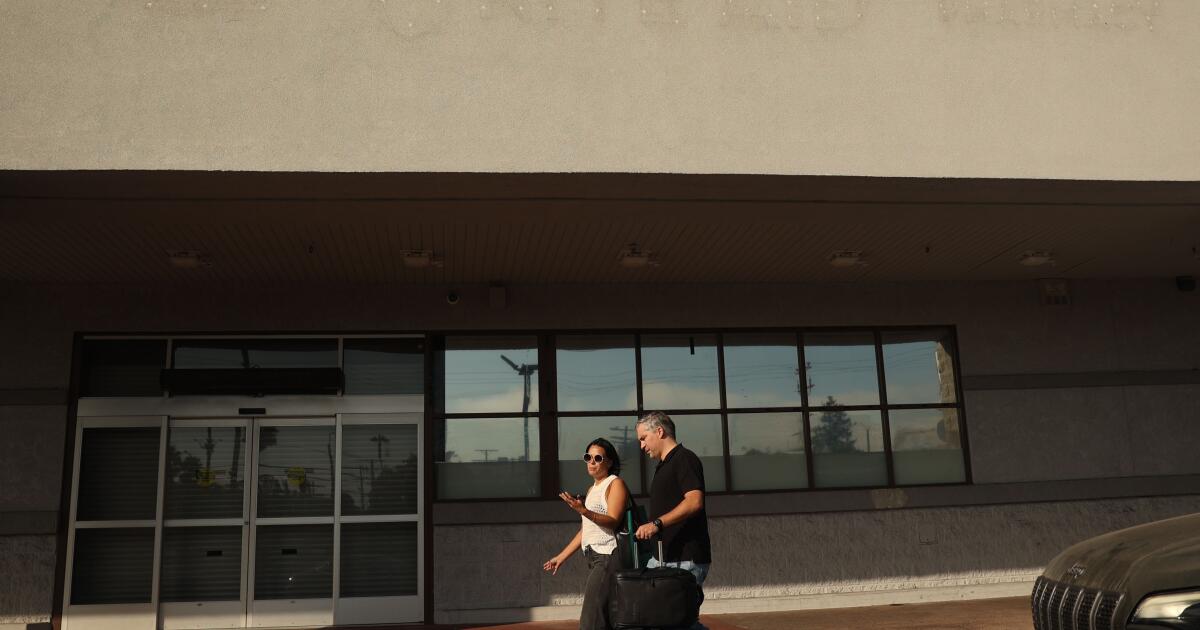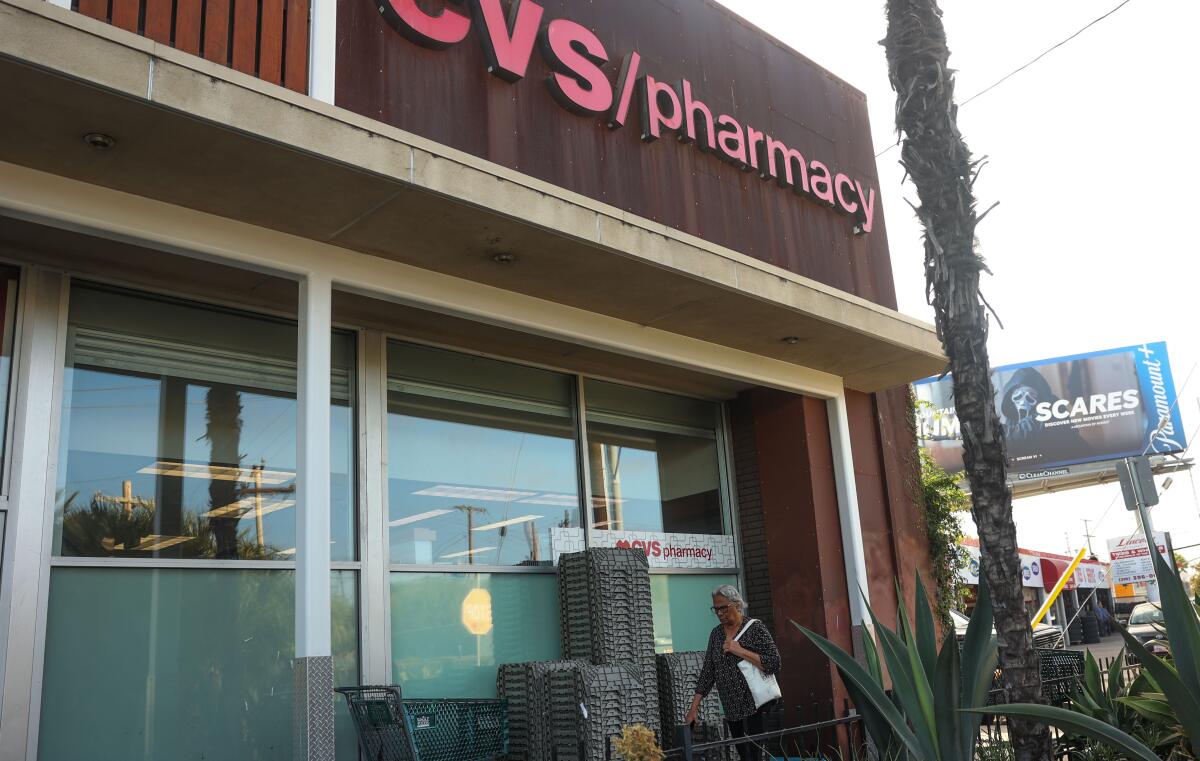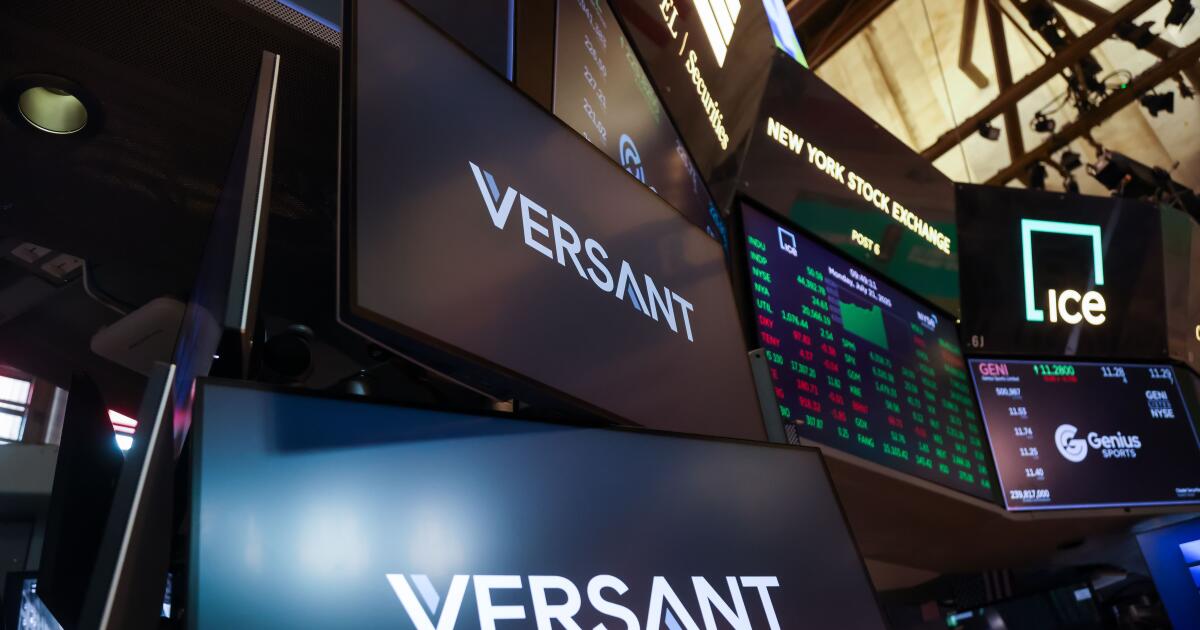Business
'My kids go to Costco now,' and other reasons Rite Aid, Walgreens and CVS are hurting

These are tough days for pharmacy chains.
From Gardena to Venice to Koreatown, storefronts that used to be Rite Aid drugstores sit empty. On Lincoln Boulevard, the outline of the Rite Aid logo can still be seen above shuttered doors.
The retail pharmacy chain has closed more than 200 stores since filing for Chapter 11 bankruptcy protection in 2023 and announced plans in July to shut down 18 more locations in California as it struggles to deal with creditors and lawsuits over opioid prescriptions.
Competitors CVS and Walgreens are also cutting costs and closing stores, reflecting challenges in the industry that have been brewing for years but have recently begun to accelerate, experts say. In June, Walgreens’ chief executive said about a quarter of the company’s 8,600 U.S. stores were underperforming and that a “significant number” of them could be closed.
Walgreens, CVS and Rite Aid are not in identical financial positions, but all three are being forced to examine their footprint and business model as they deal with lowering margins and changing consumer trends.
“Between the pressure on the front of the store plus the pressure on the pharmacy, it’s just getting harder and harder for these guys to operate,” said Brian Tanquilut, an industry analyst at Jefferies.
On the retail side, chain pharmacies are facing heavy competition from giants such as Amazon and Walmart, a drop in consumer spending and an increase in theft that can eat into profits, analysts said. On the pharmaceutical side, they’re seeing lower margins because of lower reimbursement rates for the drugs they provide to customers.
Much of the pharmacy pinch is rooted in the companies’ dependence on intermediaries called pharmacy benefit managers, or PBMs, who have significant control over how much pharmacies get reimbursed for the drugs they sell to customers.
Two of the largest benefit management companies, OptumRX and Caremark, are owned by insurance companies that have been looking to cut costs by pushing down reimbursement rates, which has punished the pharmacies’ bottom lines.
“The PBMs, all of which now are owned by the insurance companies, have been squeezing what they pay for drugs,” Tanquilut said. “As that has continued to come down, the profitability of these pharmacies has also waned,” he said.
Overall, the three pharmacy chains have struggled on Wall Street this year.
Walgreens stock price, which closed Friday at $9.25, has plummeted more than 65% since the start of the year. In June, when it missed earnings expectations for the quarter, the company warned investors it was bracing for more gloomy performance figures and cut its financial forecast for the fiscal year that ended in August.
A man rides his bike by Walgreens on Friday, Aug. 30, 2024 in Venice.
(Michael Blackshire / Los Angeles Times)
Rite Aid’s languishing stock, meanwhile, took a nosedive when the company entered bankruptcy late last year and the New York Stock Exchange moved to delist it.
CVS stands on slightly more solid ground, said Raymond James healthcare analyst John Ransom, because it owns insurance company Aetna, as well as Caremark, the pharmacy benefit manager.
“CVS is an integrated company,” Ransom said. “They’ve been able to integrate Caremark into the drug retail business in a way that’s made the drug retail business more healthy.”
But that has not made the company immune to market forces. Its stock, which closed at $57.24 Friday, is down 29% this year. CVS slashed its financial outlook and embarked on a $2-billion cost-cutting plan in early August. The company has also been closing locations since 2021, when it announced a realignment plan that would close 900 stores over three years.
CVS is on track to finish its store closures by the end of this year. After the closures, 85% of U.S. residents will still live within 10 miles of a CVS, said Amy Thibault, lead director of external communications for the company.

A woman walks by a CVS/Pharmacy on Friday, Aug. 30, 2024 in Venice.
(Michael Blackshire / Los Angeles Times)
“The store closure decisions are based on population shifts, consumer buying patterns, a community’s store density, maintaining access to pharmacy services, and future health needs to ensure we have the right kinds of stores in the right locations for consumers,” she said.
There is an overcrowding of drugstores in the country partly as a result of a real estate binge in the ‘90s, Ransom said.
“They’re shutting these stores down in urban markets where you go to a street corner and you see four pharmacies,” he said. “I think part of it is they did it to themselves.”
Walgreens external communications manager Samantha Stansberry said the company is being affected by increased regulatory and reimbursement pressures as well as higher levels of inflation, theft and other types of losses.
“Like most retailers, we have been facing a challenging operating environment,” Stansberry said. “These factors have resulted in a growing number of store closures across the country as we invest in our other locations to deliver a consistent customer experience.”
Walgreens was poised to acquire Rite Aid in a merger in 2015, but the deal ultimately fell through.
Koreatown resident Darleen Stoker was recently shopping at a Rite Aid on Larchmont Boulevard in Hancock Park and noticed rows of empty shelves. She wondered if it was a sign that the location was closing, she said.
“My kids go to Costco now,” Stoker said. “Rite Aid is more for when you realize last minute you need nail polish.”
Other customers in the store said the shelves have been empty for at least two months.
Rite Aid did not respond to multiple requests for comment.
“The remaining Rite Aid stores face a lot of the challenges that they were facing when they were trying to bridge with Walgreens,” Tanquilut said. “It’s a lot of pressure from other retailers, whether that’s the dollar stores, the Walmarts, the Targets of the world, or online retail like Amazon.”
Retail pharmacies are also struggling to adapt to a changing consumer more focused than ever on value, Tanquilut said. Customers have started to realize that sodas cost less at a grocery store than a drugstore, he said.
As inflation drives everyday costs up, consumers are tightening their belts and may be limiting impulse purchases on items found at a drugstore such as snacks and beauty products. A significant portion of purchases at drugstores are spontaneous, Tanquilut said, as customers roam around waiting for their prescription.
Tanquilut said the closing of locations could help CVS, Walgreens and Rite Aid weather the harsh industry conditions that have prompted cost-cutting measures. The density of pharmacies in the country is higher than it needs to be, he said.
“We are ‘over-pharmacied’ as a society,” Tanquilut said. “From a profitability perspective and from a competition perspective, reducing the number of retail pharmacies is not a bad thing.”

Business
Versant launches, Comcast spins off E!, CNBC and MS NOW

Comcast has officially spun off its cable channels, including CNBC and MS NOW, into a separate company, Versant Media Group.
The transaction was completed late Friday. On Monday, Versant took a major tumble in its stock market debut — providing a key test of investors’ willingness to hold on to legacy cable channels.
The initial outlook wasn’t pretty, providing awkward moments for CNBC anchors reporting the story.
Versant fell 13% to $40.57 a share on its inaugural trading day. The stock opened Monday on Nasdaq at $45.17 per share.
Comcast opted to cast off the still-profitable cable channels, except for the perennially popular Bravo, as Wall Street has soured on the business, which has been contracting amid a consumer shift to streaming.
Versant’s market performance will be closely watched as Warner Bros. Discovery attempts to separate its cable channels, including CNN, TBS and Food Network, from Warner Bros. studios and HBO later this year. Warner Chief Executive David Zaslav’s plan, which is scheduled to take place in the summer, is being contested by the Ellison family’s Paramount, which has launched a hostile bid for all of Warner Bros. Discovery.
Warner Bros. Discovery has agreed to sell itself to Netflix in an $82.7-billion deal.
The market’s distaste for cable channels has been playing out in recent years. Paramount found itself on the auction block two years ago, in part because of the weight of its struggling cable channels, including Nickelodeon, Comedy Central and MTV.
Management of the New York-based Versant, including longtime NBCUniversal sports and television executive Mark Lazarus, has been bullish on the company’s balance sheet and its prospects for growth. Versant also includes USA Network, Golf Channel, Oxygen, E!, Syfy, Fandango, Rotten Tomatoes, GolfNow, GolfPass and SportsEngine.
“As a standalone company, we enter the market with the scale, strategy and leadership to grow and evolve our business model,” Lazarus, who is Versant’s chief executive, said Monday in a statement.
Through the spin-off, Comcast shareholders received one share of Versant Class A common stock or Versant Class B common stock for every 25 shares of Comcast Class A common stock or Comcast Class B common stock, respectively. The Versant shares were distributed after the close of Comcast trading Friday.
Comcast gained about 3% on Monday, trading around $28.50.
Comcast Chairman Brian Roberts holds 33% of Versant’s controlling shares.
Business
Ties between California and Venezuela go back more than a century with Chevron

As a stunned world processes the U.S. government’s sudden intervention in Venezuela — debating its legality, guessing who the ultimate winners and losers will be — a company founded in California with deep ties to the Golden State could be among the prime beneficiaries.
Venezuela has the largest proven oil reserves on the planet. Chevron, the international petroleum conglomerate with a massive refinery in El Segundo and headquartered, until recently, in San Ramon, is the only foreign oil company that has continued operating there through decades of revolution.
Other major oil companies, including ConocoPhillips and Exxon Mobil, pulled out of Venezuela in 2007 when then-President Hugo Chávez required them to surrender majority ownership of their operations to the country’s state-controlled oil company, PDVSA.
But Chevron remained, playing the “long game,” according to industry analysts, hoping to someday resume reaping big profits from the investments the company started making there almost a century ago.
Looks like that bet might finally pay off.
In his news conference Saturday, after U.S. Special Forces snatched Venezuelan President Nicolás Maduro and his wife in Caracas and extradited them to face drug-trafficking charges in New York, President Trump said the U.S. would “run” Venezuela and open more of its massive oil reserves to American corporations.
“We’re going to have our very large U.S. oil companies, the biggest anywhere in the world, go in, spend billions of dollars, fix the badly broken infrastructure, the oil infrastructure, and start making money for the country,” Trump said during a news conference Saturday.
While oil industry analysts temper expectations by warning it could take years to start extracting significant profits given Venezuela’s long-neglected, dilapidated infrastructure, and everyday Venezuelans worry about the proceeds flowing out of the country and into the pockets of U.S. investors, there’s one group who could be forgiven for jumping with unreserved joy: Chevron insiders who championed the decision to remain in Venezuela all these years.
But the company’s official response to the stunning turn of events has been poker-faced.
“Chevron remains focused on the safety and well-being of our employees, as well as the integrity of our assets,” spokesman Bill Turenne emailed The Times on Sunday, the same statement the company sent to news outlets all weekend. “We continue to operate in full compliance with all relevant laws and regulations.”
Turenne did not respond to questions about the possible financial rewards for the company stemming from this weekend’s U.S. military action.
Chevron, which is a direct descendant of a small oil company founded in Southern California in the 1870s, has grown into a $300-billion global corporation. It was headquartered in San Ramon, just outside of San Francisco, until executives announced in August 2024 that they were fleeing high-cost California for Houston.
Texas’ relatively low taxes and light regulation have been a beacon for many California companies, and most of Chevron’s competitors are based there.
Chevron began exploring in Venezuela in the early 1920s, according to the company’s website, and ramped up operations after discovering the massive Boscan oil field in the 1940s. Over the decades, it grew into Venezuela’s largest foreign investor.
The company held on over the decades as Venezuela’s government moved steadily to the left; it began to nationalize the oil industry by creating a state-owned petroleum company in 1976, and then demanded majority ownership of foreign oil assets in 2007, under then-President Hugo Chávez.
Venezuela has the world’s largest proven crude oil reserves — meaning they’re economical to tap — about 303 billion barrels, according to the U.S. Energy Information Administration.
But even with those massive reserves, Venezuela has been producing less than 1% of the world’s crude oil supply. Production has steadily declined from the 3.5 million barrels per day pumped in 1999 to just over 1 million barrels per day now.
Currently, Chevron’s operations in Venezuela employ about 3,000 people and produce between 250,000 and 300,000 barrels of oil per day, according to published reports.
That’s less than 10% of the roughly 3 million barrels the company produces from holdings scattered across the globe, from the Gulf of Mexico to Kazakhstan and Australia.
But some analysts are optimistic that Venezuela could double or triple its current output relatively quickly — which could lead to a windfall for Chevron.
The Associated Press contributed to this report.
Business
‘Stranger Things’ finale turns box office downside up pulling in an estimated $25 million

The finale of Netflix’s blockbuster series “Stranger Things” gave movie theaters a much needed jolt, generating an estimated $20 to $25 million at the box office, according to multiple reports.
Matt and Ross Duffer’s supernatural thriller debuted simultaneously on the streaming platform and some 600 cinemas on New Year’s Eve and held encore showings all through New Year’s Day.
Owing to the cast’s contractual terms for residuals, theaters could not charge for tickets. Instead, fans reserved seats for performances directly from theaters, paying for mandatory food and beverage vouchers. AMC and Cinemark Theatres charged $20 for the concession vouchers while Regal Cinemas charged $11 — in homage to the show’s lead character, Eleven, played by Millie Bobby Brown.
AMC Theatres, the world’s largest theater chain, played the finale at 231 of its theaters across the U.S. — which accounted for one-third of all theaters that held screenings over the holiday.
The chain said that more than 753,000 viewers attended a performance at one of its cinemas over two days, bringing in more than $15 million.
Expectations for the theater showing was high.
“Our year ends on a high: Netflix’s Strangers Things series finale to show in many AMC theatres this week. Two days only New Year’s Eve and Jan 1.,” tweeted AMC’s CEO Adam Aron on Dec. 30. “Theatres are packed. Many sellouts but seats still available. How many Stranger Things tickets do you think AMC will sell?”
It was a rare win for the lagging domestic box office.
In 2025, revenue in the U.S. and Canada was expected to reach $8.87 billion, which was marginally better than 2024 and only 20% more than pre-pandemic levels, according to movie data firm Comscore.
With few exceptions, moviegoers have stayed home. As of Dec. 25., only an estimated 760 million tickets were sold, according to media and entertainment data firm EntTelligence, compared with 2024, during which total ticket sales exceeded 800 million.
-

 World1 week ago
World1 week agoHamas builds new terror regime in Gaza, recruiting teens amid problematic election
-

 Indianapolis, IN1 week ago
Indianapolis, IN1 week agoIndianapolis Colts playoffs: Updated elimination scenario, AFC standings, playoff picture for Week 17
-

 News1 week ago
News1 week agoFor those who help the poor, 2025 goes down as a year of chaos
-

 World1 week ago
World1 week agoPodcast: The 2025 EU-US relationship explained simply
-

 Business1 week ago
Business1 week agoInstacart ends AI pricing test that charged shoppers different prices for the same items
-

 Business1 week ago
Business1 week agoApple, Google and others tell some foreign employees to avoid traveling out of the country
-

 Politics1 week ago
Politics1 week ago‘Unlucky’ Honduran woman arrested after allegedly running red light and crashing into ICE vehicle
-

 Technology1 week ago
Technology1 week agoChatGPT’s GPT-5.2 is here, and it feels rushed
















